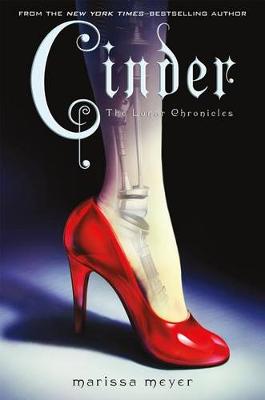Reviewed by girlinthepages on
Now, why some may call the plot predictable, I didn’t mind because it gave me a firm framework for the story to hold on to while I read despite not being very familiar with the sci-fi aspects (I admit, this is my first experience reading a book with cyborgs). Marissa Meyer does a decent job with world building, and more and more details about Cinder’s world are revealed throughout the course of the book: the time period is after World War IV, Earth has been re-distributed into new continents that provide and interesting hybridization of today’s cultures (the Eastern Commonwealth, the European Federation, etc), technology has led to colonization of the moon (Sailor Moon inspired-references!) and a plague (the “blue fever,” a parallel to the bubonic play) is ravaging the Earth.
Though many of the characters in Cinder were fairytale tropes from Cinderella, their nuances and the way that Meyer played on these stereotypes were really interesting to read. Cinder, who has no memory past age 11, is a cyborg, mechanic, witty, strong, determined, and has the resilience of her fairytale-inspiration: no matter how often she gets beat down by her stepmother and society, she does what she feels is right (note that she isn’t idealistically self sacrificing all the time) and develops close relationships with the few androids and humans who show her compassion. Cinder is definitely not a damsel-in-distress type, and her relationship and encounters with Prince Kai (whom is so endearing, I love reading about a good guy for a change) are humorous but also somewhat realistic, and she acknowledges the social and political barriers that divide them. Adri, Cinder’s stepmother, and her stepsister Pearl are deliciously awful, antagonists that readers will love to hate, but pale in comparison to the real villain, which is an element Meyer adds in that deviates from the Cinderella storyline a bit and makes the novel more original. Iko, Dr. Erland, and Peony are also peripheral characters worth mentioning, and all secondary characters serve to enhance and grow Cinder’s characters through her interactions with her.
Meyer also doesn’t focus on Cinder’s looks, but more on her capabilities and technologies, as both a person and a cyborg, a breath of fresh air in the YA (and fairytale) genre where the protagonists are stunningly-unassuming beauties that the male instantly falls for. Cinder may be influenced by a fairytale, but she shoes agency and capability far more than any males in the series, and her strength cannot be questioned.
Cinder was a fast read that sucked me in and had me flipping the pages, engaged by the hybrid of fairytale familiarity from my childhood and sci-fi world building from Meyer’s own imagination. As in fairytales, many of the situations in the book were moral dilemmas for the characters, and reading about their struggles and choices were interesting and thought-provoking, especially as they could be real problems our society faces in the future. Notable was the repulsion by the general human population toward cyborgs, humans who have a degree of prosthetic limbs and central wiring implanted in surgeries to humans who have suffered what would usually be fatal injuries. While I would be inclined to think these people are medical marvels (and often have cool abilities from their surgeries), society views cyborgs as “disgusting,” and the book thus provides an interesting view on discrimination that I hope is explored further through the next few books.
Yet the book was not the deepest nor the most intricate in world building that I’ve read in YA fantasy/fiction this year (Days of Blood and Starlight comes to mind), there’s such fun in reading a new twist of a classic story, even if I had guessed one of the major plot points early on (though there were some other curveballs I enjoyed that surprised me while reading). I literally went to my local, independent bookstore the next day and picked up Scarlet, the sequel, because I cannot wait to continue indulging in this alternative world, and I recently discovered that the entire series will be comprised of books with fairytale twists (Scarlet is based on Little Red Ridinghood)! The Lunar Chronicles are fun yet familiar reads due to their fairy tale roots that can appeal to many readers of many genres, due to its hybrid nature. Whether you’re a Grimms Brothers/Disney-buff, sci-fi fan, or general fantasy lover, Cinder is definitely worth your time.
Reading updates
- Started reading
- 26 March, 2014: Finished reading
- 26 March, 2014: Reviewed
